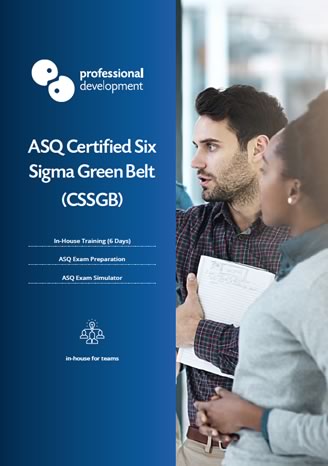ASQ Certified Six Sigma Green Belt Training
In-Company Courses » Lean Six Sigma » ASQ Certified Six Sigma Green Belt Training- This course is intensive exam preparation for the ASQ Certified Six Sigma Green Belt (CSSGB) exam.
- We include 365 days of unlimited access to an online ASQ Exam Simulator for each participant.
- It is available for in-house (in-company) bookings only. Interested in a public green belt training?
- In-house training enables you to choose the training dates and format. We can come to you or deliver online.
- Our ASQ exam preparation training is delivered by experienced, qualified Lean six Sigma experts.
Choose your training delivery style:
In-HouseTraining exclusively for your team
ASQ Six Sigma Green Belt
- Style: Exam Preparation
- Duration: 6 Days
- In-House: Tailored training for teams
- Styles: Classroom or Virtual
- Locations: Online or Onsite
This is exam preparation for those who want to achieve the prestigious ASQ Certified Six Sigma Green Belt (CSSGB) qualification. Combining intensive classroom or live virtual training with unlimited access to an online exam simulator for 365 days, this programme is designed to equip participants with an understanding of the Certified Six Sigma Body of Knowledge, confidence to apply these skills effectively, and the knowledge required to pass the ASQ examination.
Attend a Public Green Belt Course
This course is for those with experience in Lean and Six Sigma tools. It is only available for in-house bookings. If you would like to attend a public course as an individual, or don't meet the ASQ eligibility requirements (see below), why not take a look at our public Green Belt Course?
How does this ASQ Certified Six Sigma Green Belt Training Work?
Trusted by Leading Irish and International Companies
Download Brochure
Get Your Brochure Instantly
ASQ Certified Six Sigma Green Belt Training- More about this course
- Discover key benefits
- Top training objectives
- Detailed course content
- Understand delivery styles
- How to get started
What is the focus of this ASQ Certified Six Sigma Green Belt Course?
This is an exam preparation course, designed to support your team in understanding the Certified Six Sigma Body of Knowledge and preparing to sit and pass the ASQ Certified Six Sigma Green Belt (CSSGB) exam.
What are the Benefits?
There are many benefits you’ll gain by choosing this focused, in-house style of training. Here are 6 major benefits of this ASQ Certified Six Sigma Green Belt Course:
Flexibility and Convenience
This is an in-house programme, meaning that we deliver training exclusively to your team online or at a venue chosen by you, and on a date that works with your schedule. This minimises any disruption to your team’s productivity levels.Customisation
Although we adhere to the syllabus required to cover the ASQ Certified Six Sigma Body of Knowledge, we can tailor the focus of the programme to be most relevant to the processes and challenges of your organisation.Strengthen and Develop Skills
The content covered during this programme will develop each participant’s skill as a process improvement specialist. Taking their skills to the next level will increase the positive impact they can have on the profitability and quality levels of your organisation.Consistency Across Your Process Improvement Teams
By attending the same training, everyone who works on process improvement initiatives within your organisation will gain a consistent level of skill, and a common terminology for Six Sigma tools and processes. This increases efficiency and improves clarity in communications.Comprehensive ASQ Green Belt Exam Preparation
This course is designed to equip your team with everything they need to pass their ASQ Certified Six Sigma Green Belt exam first time. During training, we cover sample questions and answers. Once training is complete, each participant gains 365 days of access to an online ASQ exam simulator.International Certification
The ASQ Certified Six Sigma Green Belt qualification is known and respected at a global level. By certifying your team at this level, you are raising the bar for the standard of improvements and process quality in your business.
Online or Classroom
This ASQ Certified Six Sigma Green Belt programme is available in two delivery formats: online or classroom. “Classroom” means we come to your location to deliver training in person. “Online” means live, trainer-led sessions that your team can connect with from wherever they are based.
Get more course delivery details by downloading our PDF brochure.
Find Out More
If you would like to know more about how an ASQ Certified Six Sigma Green Belt course could work in your company, we would love to hear from you. Call us at Freephone 1800 910 810 to speak with our expert training consultants. Alternatively, click below to get a quote or ask a question.
What is covered during this ASQ Certified Six Sigma Green Belt Course?
We have outlined our standard course content below. As this this an exam preparation course, we must adhere to the syllabus. However, the in-house format enables us to tailor the content around processes and challenges within your business. Get a quote for your business to find out more about how this happens.
Module 1 - Overview: Six Sigma and the Organisation
Six Sigma and Organisational Goals
- Value of Six Sigma
- Organisational goals and six sigma projects
- Organisational drivers and metrics
Lean Principles in the Organisation
- Lean concepts
- Value-stream mapping
Design for Six Sigma (DFSS) Methodologies
- Road maps for DFSS
- DMADV (define, measure, analyse, design, verify)
- IDOV (identify, design, optimise, verify)
- alignment with DMAIC
- Basic failure mode and effects analysis (FMEA)
- Design FMEA and process FMEA
Exam Questions and Answers
Module 2 - Define Phase
Project Identification
- Project selection
- Process elements
- Benchmarking
- Process inputs and outputs
- SIPOC model
- Owners and stakeholders
Voice of the Customer
- Customer identification
- Customer data
- Customer requirements
- quality function deployment (QFD)
Project Management Basics
- Project charter
- Project scope
- Project Metrics
- primary metrics
- consequential metrics
- Project planning tools
- Gantt charts
- critical path method (CPM)
- program evaluation and review technique (PERT)
- Project documentation
- Project risk analysis
- Project closure
Management and Planning Tools
- Affinity diagrams
- Interrelationship diagraphs
- Tree diagrams
- Prioritisation matrices
- Matrix diagrams
- Process decision program charts (PDPC)
- Activity network diagrams
Exam Questions and Answers
Module 3 - Measure Phase
Process analysis and documentation
Probability and statistics
- Basic probability concepts
- independent events
- mutually exclusive events
- multiplication rules
- permutations
- combinations
- Central limit theorem
- confidence intervals
- hypothesis testing
- control charts
Statistical distributions
- Normal
- Binomial
- Poisson
- Chi square
- Student's T
- F
Collecting and summarising data
- Types of data and measuring scales
- Sampling and data collection methods
- Descriptive statistics
- Graphical methods
- scatter diagrams
- normal probability plots
- histograms
- stem-and-leaf plots
- box-and-whisker plots
Measurement System Analysis (MSA)
- Gauge repeatability and reproducability
- Measurement correlation
- Bias
- Linearity
- Pere
Process and Performance Capability
- Process performance v process specifications
- Process capability studies
- Process capability (Cp, Cpk) and process performance (Pp, Ppk) indices
- Short-term v long term capability and sigma shift
Exam Questions and Answers
Module 4 - Analyze Phase
Exploratory data analysis
- Multi-vari studies
- Correlation and linear regression
Hypothesis testing
- Basics
- statistical and practical significance
- sample sizes
- tests for significance level
- power
- type I and type II errors
- Tests for means, variances, and proportions
- hypothesis tests
- paired-comparison t-test
- F-test
- ANOVA
- chi-square
Exam Questions and Answers
Module 5 - Improve Phase
Design of Experiments (DOE)
- Basic terms
- DOE graphs and plots
- Root cause analysis
- cause and effect diagrams
- relational matrices
- problem-solving tools
Lean Tools
- Waste elimination
- pull systems
- kanban
- 5S
- standard work
- poka-yoke
- Cycle-time reduction
- Kaizen and kaizen blitz
Exam Questions and Answers
Module 6 - Control Phase
Statistical process control (SPC)
- SPC basics
- Rational subgrouping
- Control charts
- X-R
- X-s
- individual and moving range (ImR or XmR)
- median
- p, np, c, and u
Control Plan
Lean tools for process control
- Total productive maintenance (TPM)
- Visual factory
Exam Questions and Answers
What are the ASQ Six Sigma Green Belt Eligibility Requirements?
This programme and ASQ certification are intended for process improvement personnel who have experience using Lean and Six Sigma continuous improvement tools. Here are the ASQ eligibility requirements for those attending this programme:
- Participants require an aptitude for data analysis and statistics.
- Participants must have a minimum of 3 years working in a process improvement environment. This must encompass utilising at least 1 of the areas in the Six Sigma Green Belt Body of Knowledge (Define, Measure, Analyse, Improve, Control).
- This must be paid working experience. Internship, coursework, or any other kind of unpaid work experience will not meet the ASQ eligibility requirements.
Unsure if your team meets ASQ eligibility requirements?
No problem! We offer a range of Lean Six Sigma certification options. Get in touch with us by Freephone on 1800 910 810, or click here to ask a quick question. We'll be happy to advise on the right fit for your organisation.
Public Courses for Lean Six Sigma Green Belt Certification
Our ASQ Six Sigma Green Belt programme is only available for group or in-house bookings. Our Lean Six Sigma Green Belt Course is an excellent alternative for those who are seeking to achieve a green belt certification through training as an individual.
What is covered during this course?
- An overview of both Lean and Six Sigma concepts
- All elements of the DMAIC Cycle: Define, Measure, Analyse, Improve, Control
- Practical techniques and criteria for launching a successful Green Belt project
- Guidelines and tips for your certification process.
This course is available for anyone to attend. We have dates throughout the year and run our public Lean Six Sigma Green Belt Course as classroom and live virtual (online) training.
Find out More
You can visit the main course webpage for our Lean Six Sigma Green Belt Training by clicking below. Alternatively, download our PDF brochure for a full course outline.













